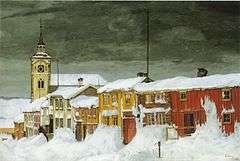World Heritage Sites in Norway
There are currently seven UNESCO World Heritage Sites in Norway. Six locations are designated to be cultural sites and one is designated to be a natural site.
Cultural Sites
- Bryggen, the old wharf of Bergen, is a reminder of the town's importance as part of the trading empire Hanseatic League from the 14th to the 16th century. Many fires, the last in 1955, have ravaged the beautiful wooden houses, although its main structure has been preserved.
- Urnes Stave Church, a stave church (stavkirke) in Luster municipality by the Sognefjorden. Stave churches were built from the 11th to the 13th century, and are a great example of traditional Scandinavian wooden architecture.

Efter snestorm, Lillegaten Røros, oil painting by Harald Sohlbeg from 1904 (titled After the snowstorm, Røros sidestreet).
- Røros Mining Town, a mining town in southern Sør-Trøndelag county. The Røros Copper Mines were active from 1644 to 1977. The town was destroyed by Swedish troops in 1679. After this, Røros was rebuilt and has about 80 wooden houses which gives the town a medieval appearance due to the dark pitch-log facades.
- Rock carvings at Alta are petroglyphs at the shores of Altafjord, in Finnmark county, north of the Arctic Circle. Thousands of paintings and engravings into rocks gives us the impression of what it must have been like living in the Far North before 4200-500 B.C.
- Vegaøyan/The Vega Archipelago at Vega in Nordland county, just south of the Arctic Circle is the name of a dozen islands, where fishermen and farmers have been living since the Stone Age. There are fishing villages, quays, warehouses, eider houses (built for eider ducks to nest in), farming landscapes, lighthouses and beacons.
- Struve Geodetic Arc is a chain of survey triangulations stretching from Hammerfest in Norway to the Black Sea. These are points of a survey, carried out between 1816 and 1855 by the astronomer Friedrich Georg Wilhelm Struve, and it represented the first accurate measuring of a long segment of a meridian arc.
- Rjukan–Notodden Industrial Heritage Site, created to protect the industrial landscape around Heddalsvatnet and Vestfjorddalen. The landscape is centered on the plant built by the Norsk Hydro to produce fertilizer from atmospheric nitrogen. The complex also includes hydroelectric power plants, transport systems, including railways, transmission lines and factories, and workers' accommodation and social institutions in the towns of Notodden and Rjukan.
Natural Site
- West Norwegian Fjords - Geirangerfjord and Nærøyfjord are the most recent addition to the list. These are typical of the Norwegian fjord landscape. Nærøyfjord is in Sogn og Fjordane county and Geirangerfjord is in Møre og Romsdal county, 200 kilometres north. The village of Geiranger is a popular destination for cruise ships.
Sources
This article is issued from Wikipedia - version of the 8/20/2016. The text is available under the Creative Commons Attribution/Share Alike but additional terms may apply for the media files.